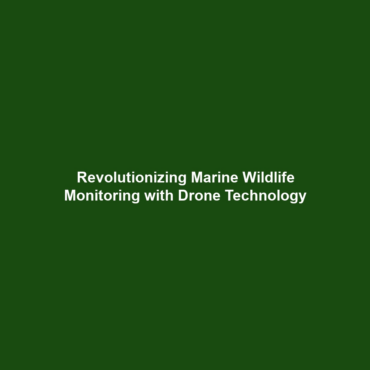Marine Wildlife Monitoring: Drones Observing Marine Life
Introduction
Marine wildlife monitoring is becoming increasingly vital in the conservation of ocean ecosystems. Drones observing marine life offer a revolutionary approach to this field by providing researchers and conservationists with the ability to monitor marine ecosystems with unprecedented efficiency and accuracy. By leveraging aerial technology, scientists can collect data on species’ behaviors, movements, and habitats, thereby enhancing our understanding of marine biodiversity. This intersection of drones and marine wildlife research not only supports conservation efforts but also exemplifies the broader potential of drones in science.
Key Concepts
Understanding Marine Wildlife Monitoring
Marine wildlife monitoring involves the systematic observation of marine species and their habitats. Drones equipped with cameras and sensors play a critical role in this process. Some key concepts include:
- Remote Sensing: Drones use sensors to capture high-resolution images and videos of marine environments from above.
- Behavioral Studies: Aerial observations allow researchers to study the behavior of marine animals without intrusive methods.
- Habitat Mapping: Drones can generate detailed maps of critical habitats, aiding in conservation planning.
Together, these concepts underscore how drones observing marine life integrate seamlessly within the category of drones in science.
Applications and Real-World Uses
Marine wildlife monitoring using drones has practical applications in various areas, including:
- Population Assessments: Drones can help estimate the population sizes of marine species like dolphins and seals.
- Habitat Conservation: By monitoring specific areas, drones help identify regions needing conservation efforts.
- Illegal Fishing Surveillance: Drones effectively monitor fishing activities to combat poaching.
These applications showcase how drones observing marine life are actively used in the broad category of drones in science to create impactful solutions.
Current Challenges
Despite their advantages, several challenges still exist in the field of marine wildlife monitoring using drones:
- Regulatory Issues: There are restrictions on drone usage in certain marine environments.
- Data Management: Large volumes of data require advanced analytical tools for effective interpretation.
- Technological Limitations: Battery life and range can pose constraints on long-term monitoring missions.
Addressing these challenges of marine wildlife monitoring is critical for the evolution of drones in science.
Future Research and Innovations
The future of marine wildlife monitoring is ripe with potential innovations and breakthroughs. Key areas of focus include:
- AI Integration: Utilizing artificial intelligence to analyze drone-collected data more efficiently.
- Enhanced Sensors: Developing advanced sensors that can detect environmental changes with greater precision.
- Multi-Species Tracking: Innovations that enable the tracking of multiple species simultaneously.
As these technologies evolve, they will profoundly impact the landscape of drones in science and enhance our capacity for marine wildlife conservation.
Conclusion
In conclusion, marine wildlife monitoring through drones observing marine life is an essential tool in conservation science. From improving data collection methods to aiding in the protection of marine biodiversity, the relevance of this technology cannot be overstated. To learn more about related topics, explore our articles on marine conservation initiatives and advanced drone technologies. By embracing these innovations, we can contribute to the preservation of our invaluable marine ecosystems.
